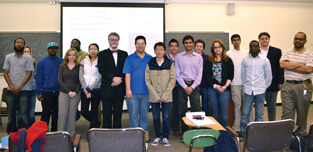
Teaching Professional Skills to University Students
ASTM Members Offer Assistance and Support for College and University Efforts

Students from the City College of New York attend the first installment of the Phase II environmental site assessments course through the college's Department of Earth and Atmospheric Sciences. Posing with students are Christopher P. McCormack (front row, fifth from left), ASTM E1903 revision task group chair, and Angelo Lampousis (back row, second from right), Ph.D., who teaches Phase I and Phase II environmental site assessment courses using ASTM standards. Photo credit: Maria Tsortanidis.
The role of standards in higher education has been described by many authors, but for the City University of New York it seems to have acquired a nearly emblematic status. In 2010, the Department of Geography of Hunter College, City University of New York, supported the pilot testing of a new course on environmental site assessments geared toward entry-level environmental professionals. The department chair, professor Ines Miyares, was very supportive of the original proposal, as was Dana Reimer, assistant to the chair. In lieu of a textbook, a package of 10 ASTM International standards was adopted as the class's core reference material, featuring standard E1527, Practice for Environmental Site Assessments: Phase I Environmental Site Assessment Process.
The course built on the Hunter College geography department's strengths in environmental sciences, geology, geographic information systems and mapping sciences. For instance, professor Charles Heatwole, who had been the department chairman for many years, led insightful labs in aerial photography, complete with the use of stereoscope. Students were also provided with access to complete environmental databases of real properties within the New York metropolitan area, through collaboration with the company Environmental Data Resources of Milford, Conn., a leading U.S. provider of environmental risk information.
Since its first offering in 2010, the ESA course was again offered in the summer of 2011. In addition, the Department of Earth and Atmospheric Sciences of City College of New York also adopted the idea and offered the same course over the last three semesters. For the spring 2012 semester, the CCNY Department of Earth and Atmospheric Sciences expanded the course concept by pilot testing a Phase II version.
ASTM members have warmly embraced this initiative by engaging in mentoring activities and offering direct feedback to students. Christopher P. McCormack, Pullman and Comley LLC, Bridgeport, Conn., and chairman of the ASTM task group revising standard E1903, Practice for Environmental Site Assessments: Phase II Environmental Site Assessment Process, visited CCNY in March as a guest speaker, sponsored by the City College of New York Student Chapter of the Society of Exploration Geophysicists. Dennis Rounds, a member of the ASTM board of directors and now a consultant based in Pierre, S.D., noted, "As the director of the South Dakota Petroleum Release Compensation Fund for over 20 years, I have overseen many hundreds of site assessments that were conducted by private environmental consultants. I wish they could have had the coursework you are offering! … It seems the curriculum you've developed ties it all together: planning, assessments, conceptual site models and remediation." Other ASTM International members who have offered valuable feedback on the development of the Phase II course include Nicholas Albergo, president of HSA Engineers and Scientists, Tampa, Fla.; and James Dismukes, president of Phase Engineering, Houston, Texas.
Another unique feature realized in the Phase II installment of the course was the integration of internships into the course work. Over the 2012 spring semester, CCNY students Neel Patel, Mariya Chiger, Fidelis Idoko and Mahmoud Dalhatu were awarded internships with the U.S. Environmental Protection Agency's Region 2 Superfund's Technical Support Team. This was the successful outcome of collaboration with the CCNY alumni network within EPA's Region 2.
Future installments of the course have been scheduled as a two-semester sequence (Phase I and Phase II) in both the Department of Geography of Hunter College and the Department of Earth and Atmospheric Sciences of CCNY for the fall semester 2012 and spring semester 2013.
Angelo Lampousis, Ph.D., is adjunct assistant professor at City College of New York and City University of New York. His research activities include monitoring of nitrate leaching on Long Island, N.Y., and basic electrical geophysics research on the broadband dielectric properties of biofuels (e.g., ethanol). The latter is research conducted on behalf of the U.S. Environmental Protection Agency.
 SN Home
SN Home Archive
Archive Advertisers
Advertisers Masthead
Masthead RateCard
RateCard Subscribe
Subscribe Email Editor
Email Editor